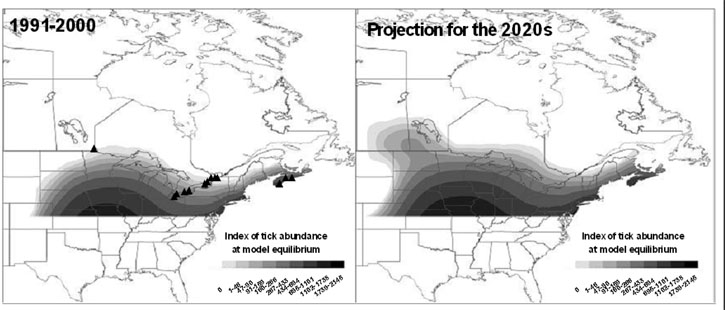Rising temperatures in Canada may be creating a safe haven for disease-carrying ticks, allowing them to spread across the country.

According to the Canada Communicable Disease Report (2008), in the early 1990s, only one population of Ixodes scapularis tick (also known as the blacklegged tick), responsible for spreading Lyme disease, was known to exist. It was found on the north shore of Lake Erie, at Long Point.
However, that is no longer the case. In fact, today, the blacklegged tick can be found across the country.
That is, in part, due to guidelines that the Public Health Agency of Canada (PHAC) has taken to document tick reports and instances of Lyme disease which seems to be on the rise in Canada. But climate change may also be to blame.
The Canada Communicable Disease Report concluded that, “Recent studies affirm the likelihood that I. scapularis will spread northwards into Canadian habitats with climate change. Furthermore there is evidence that climate warming as already occurred over the last decade or so, perhaps influencing the increased rate of establishment of I. scapularis in Canada during recent years.”
Lyme disease is caused by the bacterium Borrelia burgdorferi and is the most common tick-borne illness in North America and Europe. Symptoms of the disease may include a fever, headache and a skin rash in the area where the tick has bitten. According to the Center for Disease Control in the United States, if it is left untreated, the infection can spread to the joints, heart and the nervous system.
Read more: Uptake of Lyme disease cases in Canada, experts warn
The PHAC says that Canadians face a low risk of being bitten by a tick that spreads Lyme disease.
- ‘Significant risk’: How will wildfires spread over the next two months?
- As Canada eyes AI growth, could electricity demands fuel climate change?
- London Drugs issues apology, says no evidence of compromised data in cyberattack
- B.C. fruit likely to be in short supply and expensive this year: produce retailers
But tell that to Lois MacLean.
MacLean told Global News that she doesn’t ever remember being bitten. But in the fall of 2004, she began to feel seriously ill.
“I had sensitive teeth. I had nerve damage in my feet. I had anxiety. I had headaches,” MacLean said. “I had vertigo. I had skin hypersensitivity, debilitating fatigue which I was told was cause by depression.”
She also lost much of her cognitive ability: when she read she couldn’t understand what she was reading. She suffered from memory loss and stuttered, often unable to find the words she needed. Doctors were at a loss to explain what she had.
She was diagnosed with fibromyalgia, chronic fatigue syndrome, irritable bowel syndrome and a slew of other illnesses. It wasn’t until 2010 when she underwent a PET scan that the doctors were able to diagnose her with Lyme disease, a disease spread by ticks.
“It’s hard to say on an annual basis how bad the numbers will be,” Doctor Robbin Lindsay, a research scientist at the Public Health Agency of Canada’s National Microbiology Laboratory told Global News. “But definitely what we’ve seen in the last few years is an expansion of the ticks into new areas.”
“It’s really been the last 5 years that we’ve seen a tremendous change. We used to find individual populations, isolated populations, relatively rarely. But in the last 5 years, we’ve seen a tremendous expansion into new areas,” Lindsay said.
Thought it’s not entirely clear just why there has been an increase of tick reports across the country, one reason could be the warming temperatures.
The International Panel on Climate Change found that from 1948 to 2010, the average temperature in Canada warmed by 1.6°C during 1948 to 2010. That rate of warming is higher than in most other parts of the world. The increased temperatures during winter and spring are the main reasons for the annual change. And the northern parts of the country are seeing the strongest warming trend.
“We think temperature is a definite factor that’s affecting the distribution of these ticks so the warmer the temperatures, the greater distribution these ticks can have,” said Lindsay. We don’t see a direct link with climate change, but it’s probably a factor in helping these ticks expand into new areas.”
–with files from Jennifer Tyron




Comments